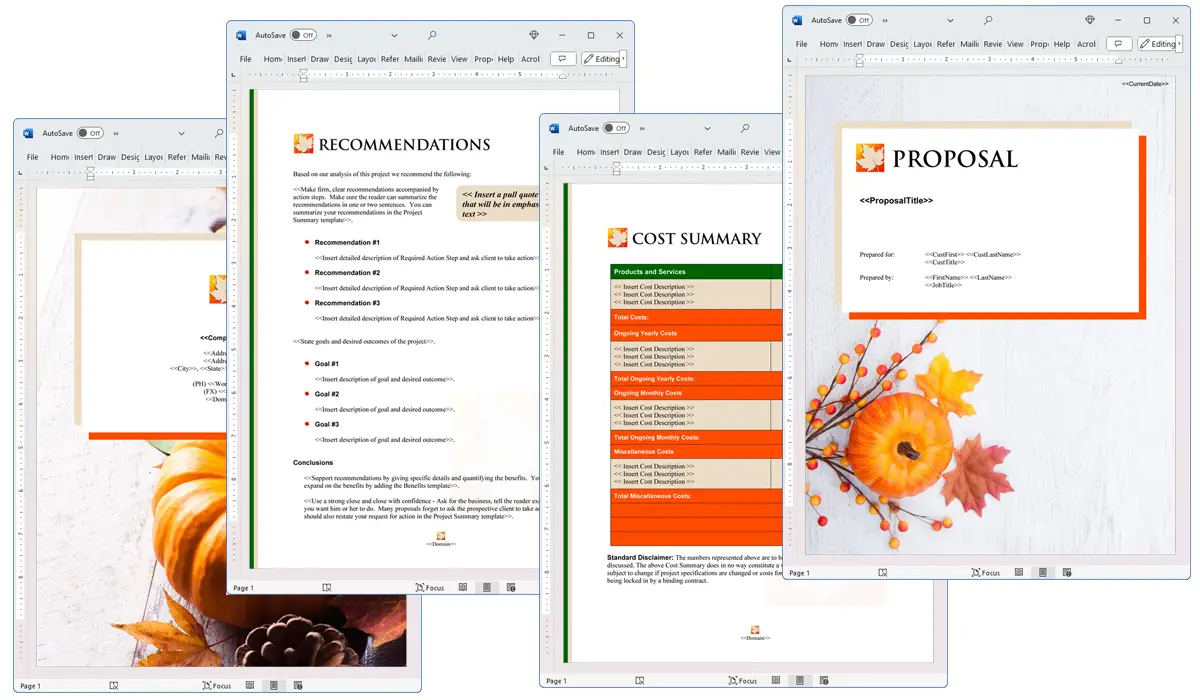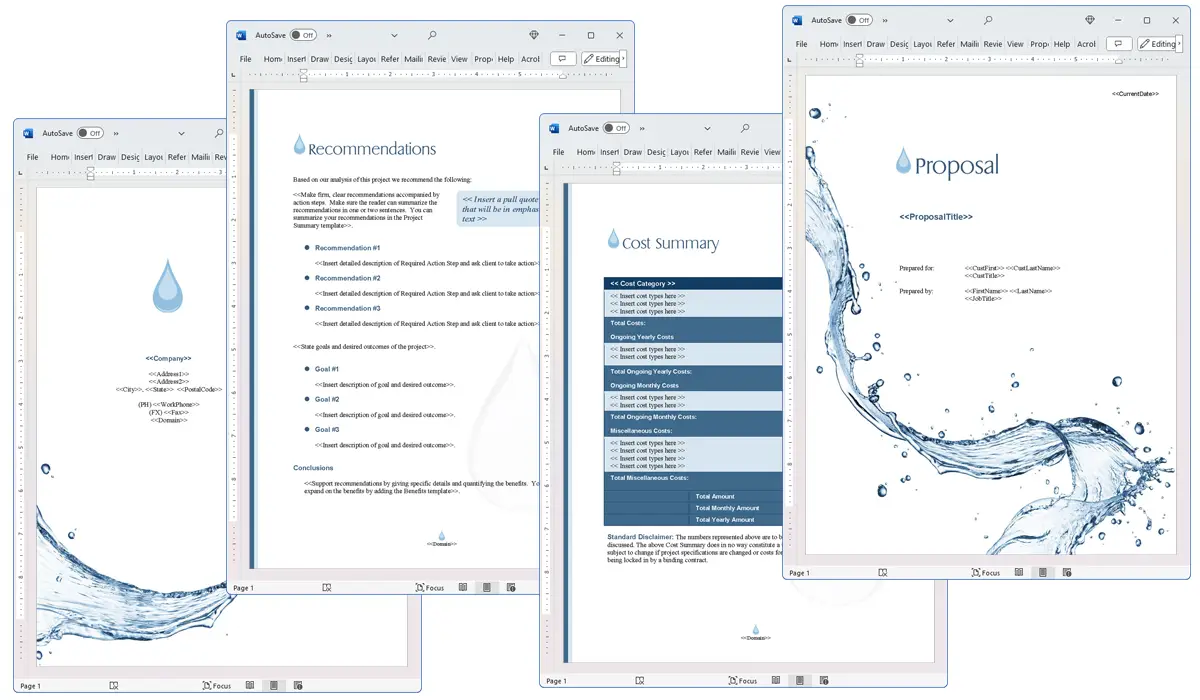What is the Uptime chapter used for?
Proposal Kit Professional Bundle adds more design themes, all six Contract Packs,
a project management library, and Expert Edition software.

Illustration of Proposal Pack Seasonal #4
We include this Uptime chapter template in every Proposal Pack, along with thousands more. You assemble this chapter with others in various combinations to create custom-tailored business proposals, plans, reports, and other documents. Proposal Packs apply custom visual designs to the templates, giving the final documents a consistent professional finish.
 DOWNLOADABLE, ONE-TIME COST, NO SUBSCRIPTION FEES
DOWNLOADABLE, ONE-TIME COST, NO SUBSCRIPTION FEES
Overview of the Uptime Chapter
The Uptime chapter is an important part of a business proposal, especially when dealing with technical services and products such as computer hardware and connection services. This chapter helps in detailing the operational reliability of these services, which is a key concern for potential clients. The stability and availability of technical services are often considered as critical factors by clients when deciding on a service provider. Therefore, the Uptime chapter serves as a dedicated section where businesses can showcase their reliability and commitment to maintaining high levels of service availability.
How is the Uptime Chapter Used?
When used in a business proposal, the Uptime chapter is used to provide explicit details about the operational time of the services or products offered. This can include a historical overview of a company's uptime, the policies in place to ensure continued service availability, or specific uptime guarantees that the company is committing to. This chapter is particularly important in proposals submitted in response to Requests for Proposals (RFPs) that specify minimum uptime requirements. By addressing these requirements directly, the company can communicate its capability to meet or exceed client expectations.
What is Included in the Uptime Chapter?
Typically, the Uptime chapter includes several key elements:
- Historical Uptime Data: This may include statistics and metrics that demonstrate the historical reliability of the company's services.
- Uptime Guarantees: Specific promises made by the company regarding the minimum operational time of their service or product.
- Uptime Policies: Descriptions of the policies and procedures in place to ensure high uptime, such as regular maintenance schedules and backup systems.
- Impact of Downtime: An analysis of how downtime is managed and mitigated, including potential impacts on the client's business.
- Recovery Plans: Details on the company's strategies for quickly restoring service after downtime.
Use Case Examples for the Uptime Chapter
The Uptime chapter can be tailored to fit various types of proposals. Here are some specific use cases:
- Web Hosting Services: A proposal for web hosting might use the Uptime chapter to detail the provider's historical uptime and their commitment to maintaining 99.9% service availability.
- IT Managed Services: In a proposal for managed IT services, this chapter could outline how the service provider manages and exceeds industry-standard uptime levels.
- Software as a Service (SaaS): For SaaS providers, the Uptime chapter might focus on cloud infrastructure reliability and the steps taken to ensure continuous service.
- Hardware Supply: A hardware supplier could use the Uptime chapter to discuss the reliability of their products under typical operating conditions.
- Technical Support Services: This chapter could highlight the provider's quick response times and effective problem-solving that contribute to overall system uptime for their clients.
Key Takeaways
- Important for Technical Proposals: The Uptime chapter is vital for proposals involving technical services or products, highlighting reliability and operational excellence.
- Addresses Client Concerns: It directly responds to potential clients' concerns about service reliability and availability.
- Showcases Company Strengths: Through detailed uptime data and policies, companies can showcase their strengths and reliability.
- Meets Specific RFP Requirements: This chapter is especially useful in responding to RFPs that have minimum uptime criteria.
- Builds Client Trust: By transparently sharing uptime metrics and guarantees, a company builds trust with potential clients.

Illustration of Proposal Pack Flag #6
 What Our Clients Say
What Our Clients SayI have been using this fantastic business tool for over three years now, It has provided me with everything to keep up with timely submission of very important proposals and most importantly keep me on top of deadlines."
Euan, Inc.
 4.7 stars, based on 845 reviews
4.7 stars, based on 845 reviewsRelated Chapters

The Uptime chapter and other chapters are integrated into a Word document as illustrated here in the Proposal Pack Aqua #5 design theme. There are hundreds of design themes available, and every design theme includes the Uptime chapter template.
A proper business proposal will include multiple chapters. This chapter is just one of many you can build into your proposal. We include the complete fill-in-the-blank template in our Proposal Pack template collections. We also include a library of sample proposals illustrating how companies in different industries, both large and small, have written proposals using our Proposal Packs. This template will show you how to write the Uptime.
We include a chapter library for you to build from based on your needs. All proposals are different and have different needs and goals. Pick the chapters from our collection and organize them as needed for your proposal.
Using the Proposal Pack template library, you can create any business proposal, report, study, plan, or document.
 Ian Lauder has been helping businesses write their proposals and contracts for two decades. Ian is the owner and founder of Proposal Kit, one of the original sources of business proposal and contract software products started in 1997.
Ian Lauder has been helping businesses write their proposals and contracts for two decades. Ian is the owner and founder of Proposal Kit, one of the original sources of business proposal and contract software products started in 1997.By Ian Lauder
 Published by Proposal Kit, Inc.
Published by Proposal Kit, Inc.


 Cart
Cart
 Facebook
Facebook YouTube
YouTube X
X Search Site
Search Site